How to Make Money Blogging: Most Profitable Strategy in 2025

How to make money blogging?
The question most new bloggers ask, while aiming to turn their hobby into a source of income.
But this type of mindset can poison your results.
If your goal is to master how to make money blogging, then it’s crucial to treat your blog like a business from the outset.
With a hundred different ways available to monetize your blog, starting a blog as a hobby is a lost opportunity.
In fact, 81% of U.S. online consumers trust information and advice from blogs, making them powerful business monetization platforms.
Yet, not all blog monetization methods are created equal.
When you start a blog, it goes through different stages like launch, scale and monetization.
The monetization stage comes in last.
However, you shouldn’t wait until you’ve fully scaled your blog to start earning income from it.
This could take years.
Instead, when learning how to make money blogging, you need to understand how different monetization strategies fit within each stage.
So, by leveraging the strategies effectively, you can start making money from your blog fast.
In this how to make money blogging guide we’ll dive deep into the tactics you can use in 2025 and beyond to turn your blog into cash flowing online business from day one.
Let’s get started!
How to Make Money Blogging?
First and foremost, take your blog online using a reliable web hosting.
The web host will store your blog’s files and make them accessible on the internet.
Bluehost is the best web hosting for beginners.
It offers reliable and fast performance, easy setup and user-friendly dashboard at an affordable price.
Start with Bluehost today and get 77% discount with my link.
Follow these steps to set up your hosting:
- Go to Bluehost and click on Get Started.
- Select the Choice Plus hosting plan.
- Create a free domain name or add it later.
- Enter your account information.
- Unselect the Package Extras.
- Click Submit to complete the purchase.
To access WordPress:
- Choose a password and log into your Bluehost account.
- Select blog when prompted and skip the rest of the on-boarding.
- Skip the choice of blog theme (we’ll deal with that later).
- Click on WordPress in the top right to access it from the Bluehost dashboard.
I cover the process in more detail in my how to start a blog guide.
Congrats! Your self-hosted WordPress blog is set up.
Now, that your blog is live, let’s scale it and explore the best strategies on how to make money blogging.
Passion Doesn’t Drive Blogging Income
Most new bloggers fall into the trap of believing the outdated advice that blogging success hinges on pursuing one’s passion.
This can’t be further from the truth.
When you think about your passions, you think about hobbies and leisure pursuits that bring you happiness outside of work.
When a beloved activity turns into a job or obligation, it diminishes the enjoyment because of the pressure to perform.
On top of that, not every passion can be monetized.
Take my passions for example:
I’m passionate about reading, outdoor exploration and collecting bearbricks.

-Source: highsnobiety.com
I’ll never make enough money to support my lifestyle and quit my day job if I start a blog on one of these topics.
And that’s okay.
Passions are for personal enjoyment without the need of turning them into a source of income.
So the question is:
Would you do something that you’re good at and makes you money?
Or would you pursue something that you’re passionate about, but won’t make you money?
Believe me, you’ll develop a genuine passion for whatever you do if it creates the life that you’ve always desired.
Therefore, don’t launch your blog based on passion and try to figure out how to make money blogging later, instead do some research first.
To put this into context, I’ll use Amazon as an example.

-Source: medium
Jeff Bezos wasn’t passionate about selling books.
However he recognized the power of the internet and understood its potential to change the way people buy and sell goods.
Books were just the ideal product to sell online due to their universal demand, wide variety (there are more book titles than any other product category), and ease of shipping.
Bazos made an informed decision based on research and statistics, not passion.
That and his obsession with customer service helped him turn Amazon, an online bookstore, into the e-commerce behemoth it’s today.
The key takeaway is:
Put your passion aside if your goal is to master how to make money blogging.
Instead, identify:
- Which niches generate the most money?
- Where does the most web traffic and demand come from?
- What are the search trends in your niche?
- Where is the monetization opportunity in your field (affiliate marketing, online courses, consultancy services, selling digital products, advertising, etc.)?
Choosing a lucrative niche is crucial for the long-term success of your blog and it’ll dictate your content strategy and monetization opportunities.
If you haven’t already, get started with Bluehost, so we can proceed with identifying and validating your niche.
How to Choose a Lucrative Blog Niche
We’ll go against the grain and we’ll not choose your blog niche based on passion; instead we’ll use a combination of key blogging metrics:
- Market Research
- Blog Earning Potential
- Affiliate Revenue
- Keyword Research
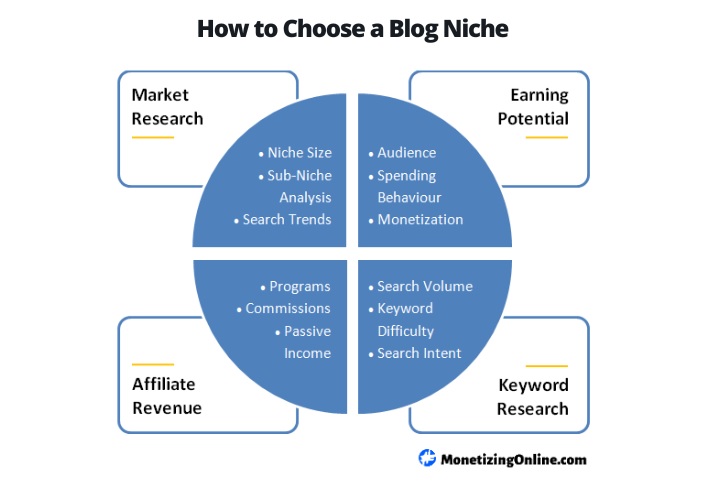
1. Market Research
Market research is pivotal when considering how to make money blogging, but it’s almost always neglected.
New bloggers skip the research and go with their passion, so they can start writing.
However, keep in mind that you’re a business owner, not just a copywriter.
You need market data to get an idea of the niche size and the competitive landscape, before you start writing.
Professional bloggers recommend focusing on a small blogging niche to avoid competition and monetize it easily.
The problems with this approach:
- Small niches have small audiences, and as a result not enough demand, scalability, and earning potential.
- A tiny niche won’t generate enough data to use as feedback to improve and adapt your content.
- Lack of competition suggests that monetization prospects are low.
The solution is simple:
Mastering how to make money blogging, requires you to pick a niche that you have knowledge and expertise in.
Consequently, you’ll build authority with your target audience faster.
You can benefit further if you’re part of that audience as you would’ve experienced their challenges and needs firsthand.
This insight will allow you to address the pain points in your content effectively by offering practical solutions.
Your niche must be broad enough as well, so you can identify different sub-niches within it.
This will enable you to pivot, if and when necessary.
Look for emerging topics in the sub-niches and cover them before the competition has entered.
You can’t force Google to rank your content but you can use its feedback to understand what sub-niches perform best.
Let the search engines do the heavy lifting for you.
Use Google Search Console to understand which areas Google considers you to be an expert in.
Pursue these by aggressively publishing content and blanket each sub-niche.
Other Things to Consider
One of the key elements when choosing a profitable niche lies in generating revenue from multiple sub-niches in the main niche.
To put this into context:
Let’s say you start a blog about personal finance, focusing on credit cards.
There’s only so much to write about and you’re restricted to revenue from one product.
Instead, you want to cover all aspects of personal finance: credit cards, savings, mortgages, loans, checking accounts, insurance, investments, pensions, budgeting and so on.
To get ahead of the curve, publish content on the emerging trends in the niche like the use of AI in personal finance, positioning your blog to outrank any new entrants.
Creating content about multiple products and services in multiple sub-niches will increase your blog’s income 10 fold.
It’s a numbers game.
If you make 10 sales per month from an affiliate program in 1 niche, the easiest way to 10x your blog’s income is by generating 10 sales in 10 sub-niches:
10 sales x 1 niche = 10 sales/month.
Compared to:
10 sales x 10 sub-niches = 100 sales/month.
You can find a niche that makes money by performing a quick 15-20 minutes market research, using the correct tools.
Here’s how to do it
Let’s assume you want to start a blog in the personal development niche.
Before you start publishing content, identity the size of the niche and the sub-niches you can cover.
Start by searching for your topic on Google.
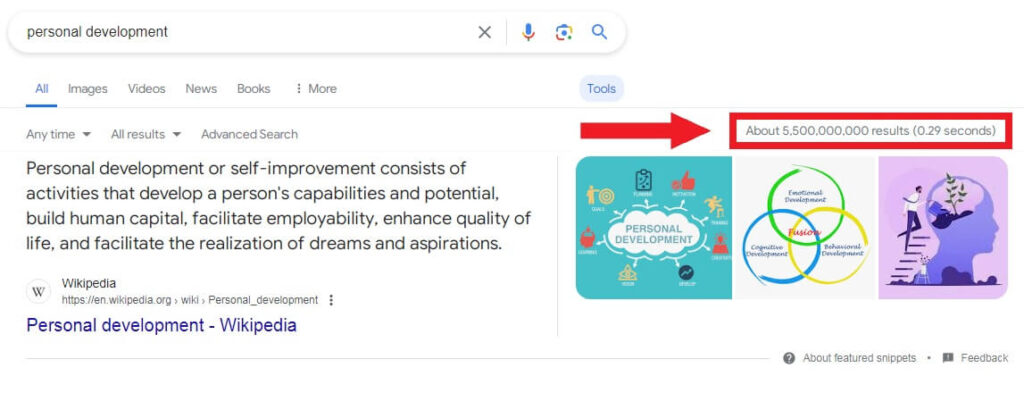
The search returns a large amount of results, suggesting that the personal development niche is broad topic with enough sub-niches.
To generate sub-niche ideas, scroll to the bottom of the Google search results page where you can find related search variations.
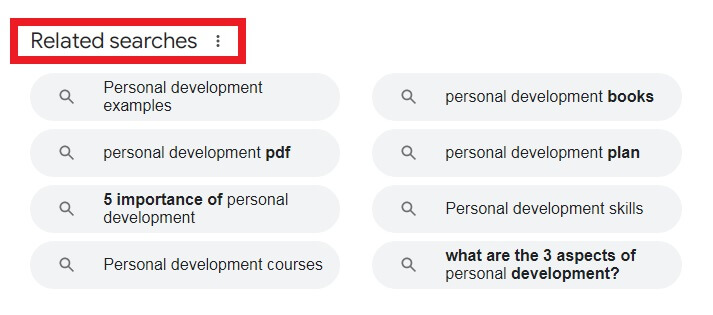
These are popular topics that people are searching for.
Now, let’s check how many people search for personal development every month.
To get the data, go to Google Ads Keyword Planner and enter the term.

The keyword has up to 100,000 average monthly searches just in the United States and low competition.
Personal development could be a good choice for a niche.
It’s a broad enough topic with several sub-categories to pursue, including time management, productivity, mindfulness, self-confidence, goal setting, meditation, communication skills, public speaking, self-awareness, emotional intelligence, etc.
To get precise monthly search data, use a tool like Semrush.
It’ll help you find a profitable niche faster.
It’s the best tool to generate a ton of other high-volume, low-competition keywords to target in your blog posts as well.
When considering how to make money blogging, it’s important to understand if the overall trend of your niche is rising or declining.
Head over to Google Trends and type in personal development.
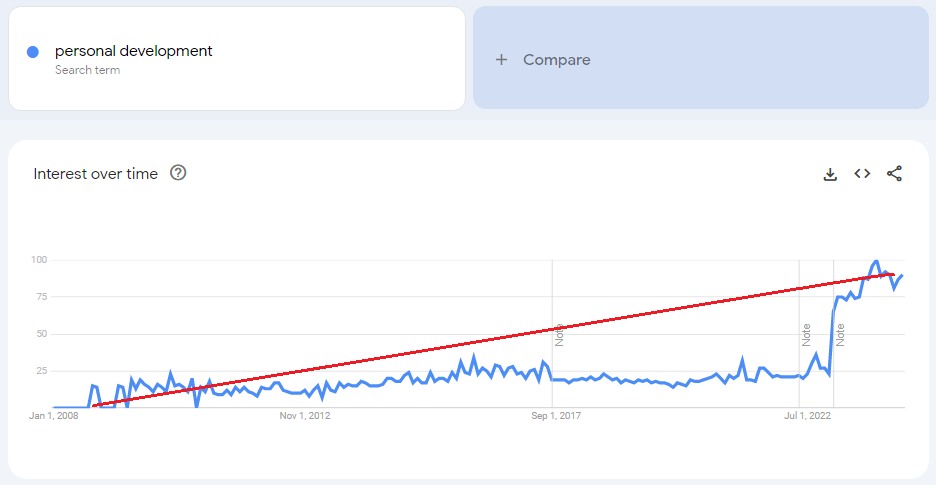
The search trend is rising, signalling that the audience in this niche is growing over time.
Remember, the trend is your friend.
Stay away from topics on a declining search trend.
If your niche is attracting more interest over time, it’ll help you grow your blog and scale it faster in line with the increasing search volume and expanding audience size.
You can also check data from industry reports.
Grand View Research reports that the global personal development market size in 2021 was $41.81 billion.
However, it’ll grow to $67.02 billion in 2030, indicating that the uptrend will continue during the next decade.
After completing the niche research, it’s time to look at the revenue potential of your audience, how to evaluate it and the role it plays in how to make money blogging.
Ready to start your blog? Power it with Bluehost and get up to 80% discount.
2. Blog Earning Potential
Three main factors can help you estimate the income potential of your blog even before you’ve started it:
- Understand your target audience.
- Determine the spending behaviour in your niche.
- Effective use of monetization methods at different stages of your blog.
Target Audience
Your goal as a blogger is to understand your audience and address their pain point by providing valuable, solution-based content.
Once the audience enters your sales funnel, you can move them down, leading them to make a purchase.
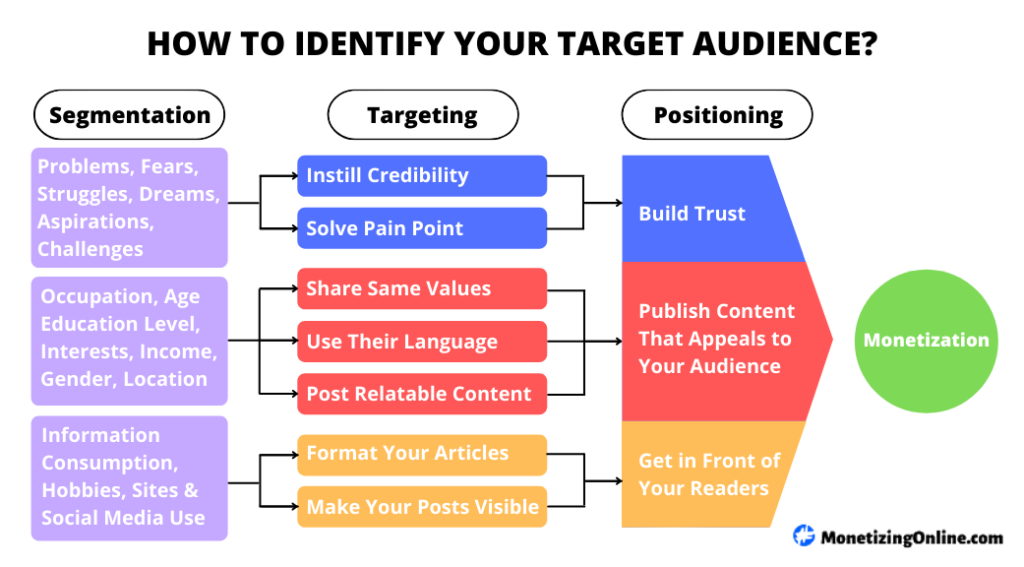
To gain a deeper insight into your audience put yourself in their position.
It’ll make it easier to understand their thinking, the challenges they face, what solutions they are looking for and the rationale behind their buying decisions.
Let’s look at Apple as an example.

-Source: apple.com
Who and why buys Apple products and what that tells us?
- The largest segment of buyers is 18-49 years old.
- Media and tech-savvy people.
- Creatives, students, professionals and business users.
- Middle to high-income consumers.
- They value quality, performance, design, innovation, advanced hardware and software capabilities.
- These consumers are willing to pay a premium for Apple products, because they believe they offer a better user experience and superior value compared to other brands.
It’s clear that you not only need to solve a problem for your audience, but you have to solve a problem your audience is prepared to pay for.
Spending Behaviour
Some of the most lucrative niches, where the audience is willing to spend the most, include food, travel, personal finance, marketing, lifestyle, mommy blogs, home decor and improvements.
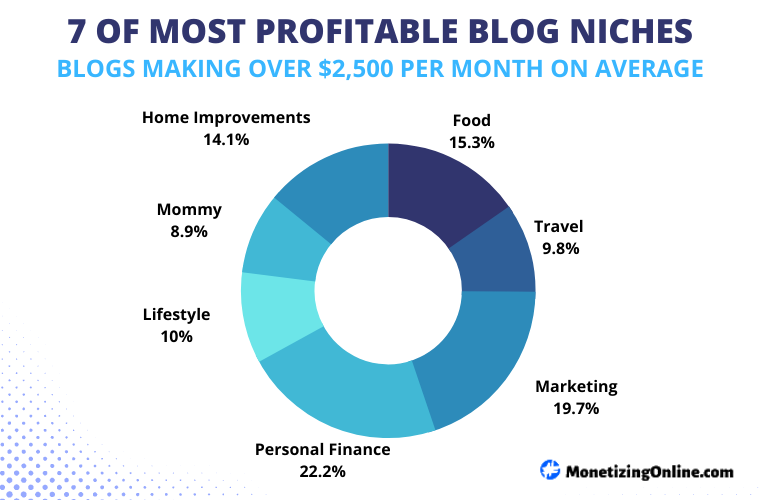
-Data source: various
To determine the income potential of your selected niche, research how much the audience is spending, and how much the competitor blogs are making?
These insights will later help you to put in place an effective monetization strategy.
Blog Monetization Options
When it comes to blog monetization, most bloggers will suggest using revenue streams like ads and affiliating programs.
These are popular choices because they’re relatively passive.
This approach however, is counterproductive since these revenue streams need a larger number of visitors to generate significant income.
A new blog will begin with a small audience and limited traffic.
Thus, you want to make the most of it by using a monetization strategy in line with your monthly visitors.
The most efficient way to monetize a new blog is through consultancy.
This low-volume, high-price business model allows you to generate revenue faster without much traffic.
Let me explain.
Consultancy services command higher prices compared to other monetization methods like displaying ads and affiliate marketing.
Clients are willing to pay higher price for personalized advice and solutions tailored to their specific needs.
The price of your services is based on the value of your expertise rather than the volume of traffic your blog gets.
Therefore, you can charge premium rates for your knowledge and experience, regardless of the size of your audience.
To supercharge your blog’s revenue, choose a lucrative niche, and instead of chasing low-revenue ads and affiliate sales in the beginning, while your traffic is low, focus on selling high-ticket consulting services.
This strategy can get you from $0.00 to $10,000 monthly income in less than 6 months.
We’re going to cover the structure of your consulting offer in more detail later on in this how to make money blogging guide.
Another overlooked way how to monetize a blog is exploring the commercial potential of your audience.
What do I mean by this?
If you start a blog about marketing, your content will likely appeal to students, people looking to enter the field, and marketing enthusiasts.
This type of audience may not have enough disposable income to pay for your services.
However, the game-changer is to add one word.
And that is – business.
This shift from marketing to business marketing will allow you to attract companies and business owners.
And the beauty of it is that companies:
- Have bigger budgets than individuals.
- Aren’t only interested in knowledge but are actively seeking business growth solutions and are willing to pay for them.
- Any purchases are business expenses, making a $2,500 monthly consultancy fee relatively inexpensive.
By closing only 2 high-paying business clients you can easily generate $5,000 a month from consulting.
Ultimately, understanding your audience and their spending habits, combined with the right monetization strategy, can transform your new blog into a thriving online business.
Focus on consulting in the beginning, because profitability hides in the numbers.
As your web traffic increases, transition from consulting to passive income streams like affiliate marketing, advertising, sale of online courses, etc.
Get started with Bluehost and receive up to 80% discount.
3. Affiliate Revenue
Choosing a blog niche that has strong affiliate revenue potential is crucial for your long-term blog profitability.
Affiliate marketing is the best way to generate passive income once your blog starts driving traffic.
It allows you to make money 24/7 without much input and you no longer need to trade time for money.
Affiliate marketing is an advertising model based on recommending products and services of other companies.
In exchange, you earn a commission on each sale through a unique link associated with the recommendation.
A niche with high affiliate revenue potential offers a wide range of products and services that you can promote, eliminating the reliance on a single affiliate program.
Some niches have higher-priced items, resulting in higher affiliate commissions per sale.
For instance, niches like technology, finance, and health often have higher ticket items compared to general lifestyle blogs.
Making more money from each transaction can significantly boost your blog’s income without needing a massive volume of sales.
Moreover, affiliate programs offer extensive tracking and analytics tools, enabling you to monitor the performance of your links and optimize your strategy accordingly.
By analyzing which products are generating the most sales, you can fine-tune your content to maximize earnings.
More on how to sign up for affiliate programs and how to make money blogging as an affiliate later in the article.
Now let’s look at the role of keyword research.
4. Keyword Research
It’s a crucial step when choosing a blog niche, providing valuable insights into the interests and search behaviours of your target audience.
Keyword research reveals the questions your audience has and problems they’re trying to solve.
Once you identify the key topics, sub-topics and valuable keywords within your niche, you can plan your content strategy.
If you’re new to keyword research, don’t worry, I got you covered.
Each blog post you publish needs to focus on one keyword.
Then, you need to know how many people are searching for it.
If no one is searching for your target keyword, no one will find your content, and your blog won’t get traffic.
It’s that simple.
So, when you start a blog, it’s useful to have a basic understanding of how to do effective keyword research, including search volume, keyword difficulty, and search intent.
Search Intent
User search intent is the specific reason why someone is searching online.
There are four types of search intent:
- Transactional– looking to make an immediate purchase.
- Informational–searching for information on a specific topic.
- Navigational –visiting a particular website, (Amazon).
- Commercial– researching a potential purchase.
Transactional posts contain an intent-specific word like “Buy” + keyword.
For example: Best Video Conferencing Software.
Whereas, informational articles include words like “How-to”, “Best-Way-to” or “Why” + keyword.
A good example is How to Start an Online Business.
Publish 60% transactional and 40% informational posts.
You only need to focus on these 2 types of search intent as they’ll drive the most traffic and revenue for your blog.
To find valuable keywords, you have to determine their monthly search volume and keyword difficulty.
Luckily, there are SEO tools available to help you understand and use the search data to your advantage.
Use Semrush to filter through keyword metrics like:
Monthly Search Volume
This is the average number of monthly searches for a given keyword.
Monthly search volumes can be: Low, Medium, High and Very High.

Keyword Difficulty (KD)
It estimates how easy it’s to rank for a keyword on the first page of Google during organic searches.
Keyword difficulty measures the competition on a scale of 1-100.
The scale is divided into 4 levels: Easy, Medium, Hard and Very Hard.

Cost-Per-Click (CPC)
This is the amount of money spent for each click in a paid marketing campaign.
Even though we don’t want to run paid ads, it’s important to know that the higher the CPC, the more commercially valuable is the word.
Keyword Ideas
To generate keyword ideas explore variations of your target keyword.
Pick the ones that have the highest search volume and the lowest competition.
Now that you understand search volume and keyword difficulty, let’s combine these individual metrics to find you valuable keywords to target.
From a search engine optimization (SEO) perspective, we can generate various combinations with these 2 components.
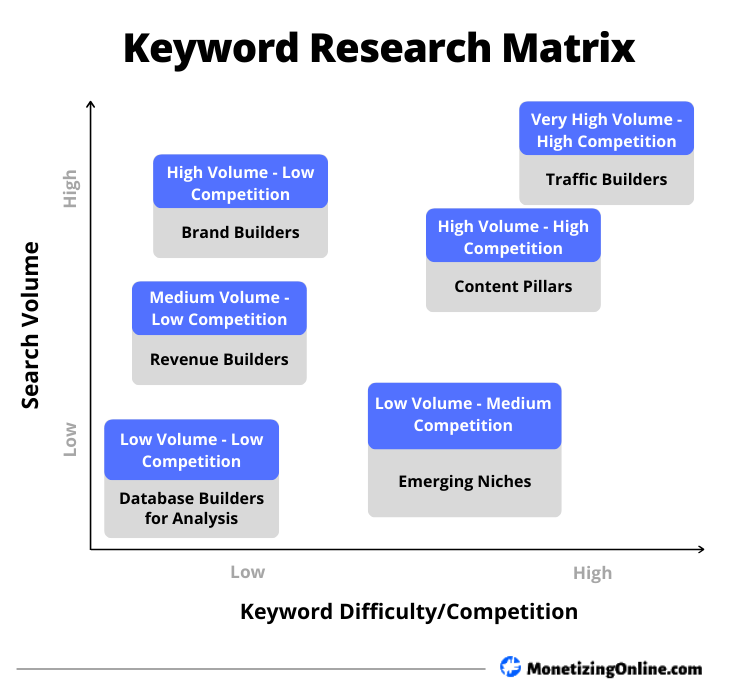
Low-volume, low-competition keywords are not commercially viable.
Avoid them.
Instead, when learning how to make money blogging, it’s essential to understand that your new blog needs a mixture of medium-volume, low-competition and very high-volume, high-competition keywords.
Let me explain.
1. Medium-Volume, Low-Competition Keywords
Find and target medium-volume, low-competition keywords in your content because these generate revenue for your blog.
For example:
If you’re creating an outdoor sports blog, you can write an article on Best Snowboard Brands.
Using the Semrush keyword research tool, we can see that the term has the following metrics:
- Keyword: Best snowboard brands
- Monthly search volume: 6,600
- Keyword difficulty: 17
- Cost-per-click: $11.79
Keyword difficulty is low at 17, suggesting that ranking for this term should be relatively easy.
And because we know that a page ranking number 1 on Google gets 32.5% traffic on average, we can calculate that position 1 will bring in 2,145 monthly organic visitors.
On top of that, your post can rank for hundreds of other variations of the main keyword, such as winter sports equipment, snowboarding gear, and equipment for snowboarding, pulling additional 1,000-2,000 monthly page visits.
The CPC is also high, suggesting that the keyword has commercial value.
The keyword contains the word “best”, indicating strong search intent which you can match with list-type, transactional blog posts.
When looking for relevant keywords to target, it’s important to search for more specific terms.
Instead of workout search for high-intensity interval training or crossfit exercises; instead of shoes, try running shoes for women.
Make sure to check the Semrush keyword suggestions for other variations of the term that you can target or include in your content and headings.
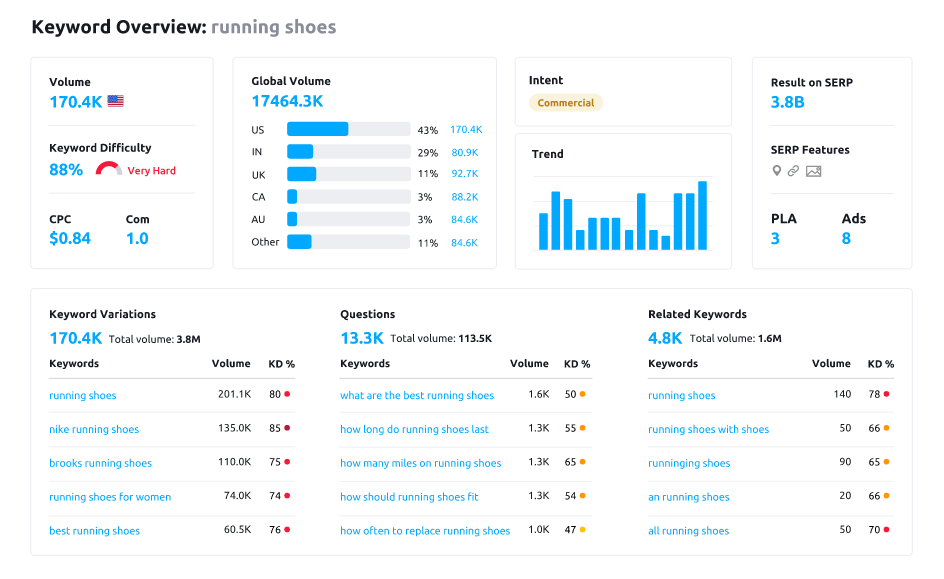
-Source: semrush
To find medium-volume, low-competition keywords in any niche, head over to Semrush.
Using the filter set the keyword search volume to a minimum of 2,000 and the keyword difficulty to a maximum of 25.
Around 80% of your posts need to cover these keywords since they’ll generate the most revenue for your blog.
Pro Tip: When you find these keywords go after them and publish content immediately, because the metrics will change as more bloggers find these terms and target them.
You also need to think about finding very high-volume, high-competition keywords in your niche.
2. Very High-Volume, High-Competition Keywords
These keywords are more difficult to monetize but can drive a ton of traffic and help you increase the size of your email list.
Let’s analyze the term How to Make Money Online.
- Keyword: How to make money online
- Search volume: 107,000
- Keyword difficulty: 63
- CPC: $1.97
On the surface, this keyword has higher search volume compared to “best snowboard brands”.
As a result, landing an article on the first page of Google can generate 15,000-25,000 monthly visits to your blog.
And with the variation of the keyword that you’ll also rank for, you can double this amount of traffic.
Furthermore, we can see that the keyword contains “how-to” suggesting the post is informational.
Therefore, it has lower search intent.
With “best snowboard brands”, we can determine exactly what the user is looking for, whereas “how to make money online” is unclear.
You can make money online in a 1000 of different ways, such as starting a blog, dropshipping, podcasting, freelancing, and more.
That’s why the CPC is only $1.97.
To find very high-volume, high-competition keywords, go to Semrush.
Using the filter options set the keyword search volume to a minimum of 20,000 and the keyword difficulty to a maximum of 65.
The keywords should appear in long-form, high-quality, detailed, informational blog posts, forming up to 40% of your overall blog content.
Your goal when searching for keywords to target is to find very high-volume, high-competition terms to use in “how-to”, informational posts that solve a pain point for your audience and drive traffic.
You also want to find medium-volume, low-competition keywords, pair them with the word “best” and include them in a list-type transactional posts to generate revenue.
Here are some of the best keyword research tools you can use:
Ultimately, when learning how to make money blogging you need to identify keywords that are both lucrative and have medium to high search volume, but low competition, so you can create content around them.
Ready to launch your blog? Get started with Bluhost from $2.95/month.
Creating Blog Content
It goes without saying that creating high-quality content, optimized for search engines is crucial for ranking higher in the search results.
Higher visibility translates into more organic traffic, paving the way for more monetization opportunities.
However, as a new blogger, you may find it challenging to scale your content rapidly.
Even if you can create high-quality content and enjoy writing, you’re still faced with time constraints.
But what if you don’t enjoy writing?
Fortunately, there are few hacks you can use to streamline the writing process and scale your content creation rapidly.
You won’t need to write a single word either.
Have you heard business owners say “I only work 2-4 hours a day”?
And have you wondered how they achieve that?
I’ll let you in on a little secret.
They do it via automation and outsourcing.
It’s that simple.
By combining these strategies you can indeed build a profitable blog with 2-4 hours of work a day.
1. Automation
Artificial Intelligence is revolutionizing content creation, offering bloggers access to powerful tools to automate most of the writing process.
AI writing assistants can generate topic ideas, write article outlines and create blog post drafts.
Overall, AI makes it possible to write content at scale without hiring, paying and managing a team of writers.
Here’s how to harness the potential of AI content writing tools:
- Blog post outlines: Tools like MarketMuse analyze existing content, create outlines and provide a solid structure for your articles.
- Draft assistance: Use AI-powered writing assistants like Jasper to generate relevant content based on given prompts, saving you time and providing new ideas.
- Edit and proofread: Leverage AI-based grammar and style checkers such as Grammarly to ensure your content is polished and error-free before publishing.
- Optimize SEO: Use SurferSEO to fine-tune your content for SEO.
It tells you the exact word count, number of heading, paragraphs and images and all the semantic keywords you need to include in your blog post to rack on the first pages of Google.
Currently, Google doesn’t penalize AI-generated content.
However, to future-proof your blog against any sudden algorithm changes, run your content through Originality AI and make sure it passes the AI content detection before publishing it.
If it detects more than 10% AI generated content, use Jasper to re-write and re-phrase some of the paragraphs.
2. Outsourcing
You should never write first drafts for blog posts.
Instead, prioritize and focus on high-value tasks that directly contribute to your blog’s growth and success.
Dedicate your time to activities like final draft editing, publishing and backlink building.
Outsource low-value tasks that drain your time and productivity like writing first drafts.
This allows you to leverage the time of other experienced writers and accomplish more in less time.
For example:
If you spend 8 hours a day writing articles, writing 5 days a week, its 40 hours of work.
8 hours a day x 5 days a week = 40 hours
However, if you outsource this task to 5 professional writers, each writing 8 hours a day, 5 days a week.
Collectively, they’ll put in 200 hours of writing for you in the same one week.
5 writers x 8 hours x 5 days = 200 hours
This significant increase in available writing hours will lead to higher output.
If you write 1 blog post a day:
1 writer x 1 post x 5 days = 5 articles a week.
Whereas, if you use 5 professionals who write 1 post a day:
5 writers x 1 post x 5 days = 25 articles a week
But how do you find experienced writers?
Platforms like Fiverr offer a pool of talented freelancers who can create high-quality and engaging blog content.
Here’s how you can make the most of such services:
Find the right freelancers:
Search for experienced writers in your niche, read their reviews and check their portfolios to ensure their style aligns with your requirements.
Clearly communicate your needs and expectations:
Provide detailed instructions, including desired tone, keywords, structure and any other specifics that will help the writer understand your vision.
Establish a long-term relationship:
When you find writers who deliver high-quality content, consider building a long-term working relationship with them.
This will streamline your content creation and ensure consistency across your blog.
Moreover, for a 1000-word blog article a freelance writer on Fiverr may charge you around $50 at the lower end and $175 at the higher end.
Pro Tip: Go for a mid to high-range writing service: $100-$150 per 1000 words to ensure the quality is there.
You can see how you can scale your blog content exponentially without writing a single word.
After uncovering the remarkable potential of automating and outsourcing your content creation, let’s take a look at building backlinks.
When it comes to mastering how to make money blogging, backlinks plays a critical role.
Backlinks Building and Acquisition
Acquiring high-quality backlinks is essential for increasing your blog’s visibility and authority on the web.
When other reputable sites link back to your content, search engines recognize it as a vote of confidence, pushing your blog higher in search results and attracting more organic traffic faster.
Let’s face it.
More web traffic = More blog revenue.
While 65% of online marketers agree that link building is the most challenging SEO tactic to execute, it’s also the most valuable.
Guest blogging is still the most effective way to build backlinks to your blog.
The Importance of Guest Blogging
Guest blogging is your content contribution to other websites within your niche.
In return, you get to include an author bio with a link to your own blog.
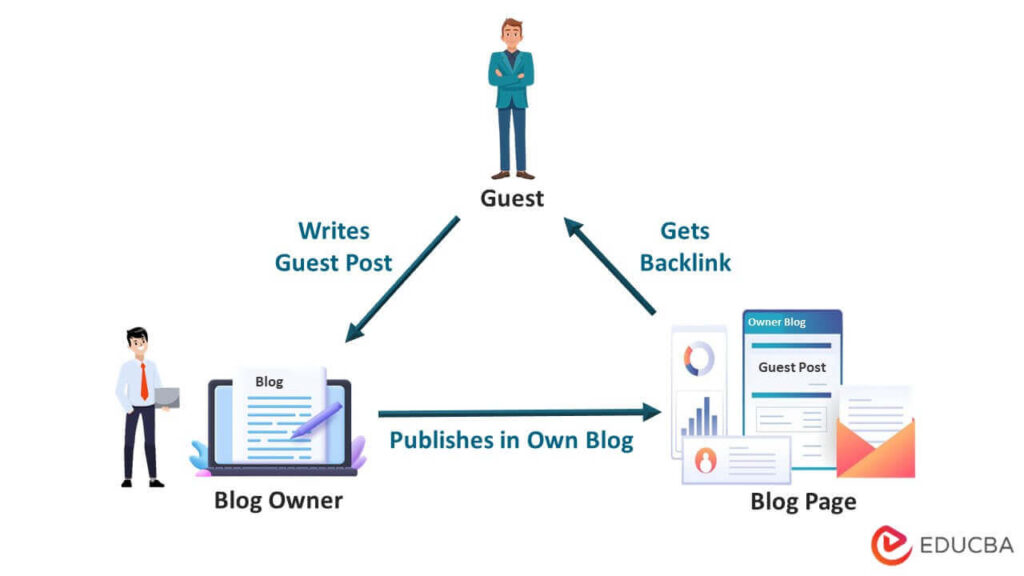
-Source: educba.com
Guest blogging is a 3 step process:
- Outreach.
- Blog post writing.
- Backlink acquisition.
Once you master the process, rinse and repeat indefinitely.
Let’s break down each step.
What do you need to know before you start guest blogging?
If you want to be successful at it, don’t focus only on what you’ll get out of it or use it just as a mechanism for acquiring backlinks.
Rather, focus on building relationships and providing value to the hosting blog and their readers.
Think about your value proposition:
- Can you offer well-researched content that aligns with their audience?
- Is there a relevant topic that the hosting blog hasn’t covered yet?
- Are there content gaps you can fill?
- Can you link back to their site in other guest posts you’re contributing elsewhere?
Understanding that what you bring to the table is crucial for creating an effective email outreach strategy.
1. Outreach
The perfect outreach consists of 5 steps.
Step 1: Start building your blog outreach list
Using a spreadsheet, create a list and track your outreach progress, including website, name, email, pitch status, and responses.
To start building your list find sites that accept guest posts.
Step 2: Research Blogs Accepting Guest Posts.
Visit blogging networks and communities like: BloggerLinkUp.
MyBlogGuest is another option that you can explore.
Alternatively, search on Google.
Search for: “write for us + [your niche]”, “blog post contribution + [your niche]” or “submit a guest post + [your niche]”.
Step 3: Evaluate Website Quality and Relevance
Be strategic and include only relevant blogs in your list with high domain authority, 50+ preferably.
Enter the URLs into Semrush Backlink Analysis Tools to determine the site’s Domain Authority score and backlink profile.
Here is also a list of the top blogs and websites accepting guest posts, including their name, niche and Domain Authority (DA).
Now that you have a solid list of vetted websites, let’s find the right person to contact.
Step 4: Find Contact Information
Check the hosting site “Write for Us“, “Contribute” or “Contact Us” pages to locate the editors or website owner’s contact details.
You can also check their LinkedIn page, or use tools like Hunter.io to find a name and email address to reach out to.
If you can’t find an exact email address, Hunter.io will at least provide you with the email structure:
[email protected] or [email protected]
Fill in the blanks using the contact’s name from LinkedIn.
Add the names and contact information to your spreadsheet.
Next, connect with these potential contacts on LinkedIn.
It’ll work in your favour if you have mutual connections.
Step 5: Pitch Your Guest Post Idea
Now that you have your list of 20-50 contacts, it’s time to reach out via email.
To accelerate your email outreach, use email templates.
This is a simple email template that I use:
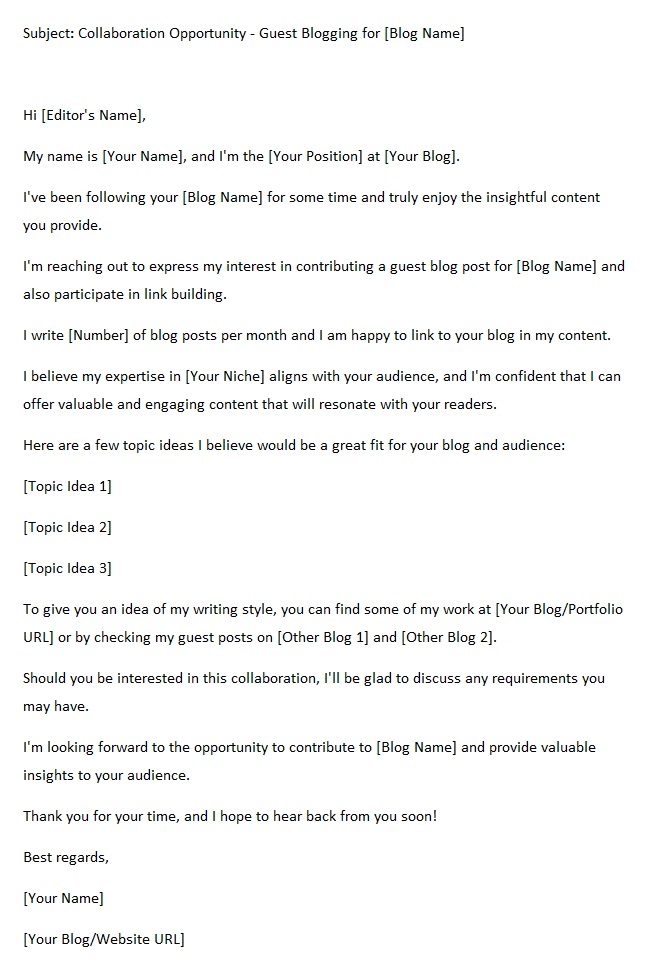
When you get a response to your email saying that they’re interested in a guest post, you need to present your content idea.
To come up with appealing blog post ideas, consider the following elements:
- Unique Content
Scan their blog and check for existing content on the topic you have in mind.
Ensure that your proposed topic isn’t already covered.
- SEO Value
Research the blog’s organic keywords using tools like Semrush to identify gaps in their content that you can fill.
Opt for keywords or topics that align with the blog’s SEO strategy, can drive traffic to their site and have long-term value (evergreen content).
- Expertise Match
Select a topic that aligns with your expertise and knowledge.
You should be able to write in-depth about the subject.
- Audience Interest
Familiarize yourself with the blog’s editorial guidelines and writing style.
Tailor your topic to match what resonates with their readers, addressing their pain points or providing solutions that align with their preferences.
After your guest blogging topic is accepted, you can proceed to the substance of the guest blogging.
2. Writing the Guest Blog Post
Writing a good guest blog post requires planning and execution.
Here are the key steps to create an engaging and effective guest blog post:
Start by familiarizing yourself with the hosting blog’s target audience, writing style, and tone and make sure your chosen topic fits.
Next, review the editorial guidelines and adhere to them.
Pay attention to their preferred word count, format, and other requirements they have for guest posts.
Deliver high-quality content that offers value to the readers.
It goes without saying that your content has to be original, engaging, and well-structured.
Address the topic thoroughly and provide actionable insights, tips, or solutions.
Support your points with evidence, statistics, and real-life examples to make your post credible.
Include target keywords naturally throughout your content to optimize it for search engines.
Use subheadings, bullet points, and numbered lists to break down your content into easy to read paragraphs.
Include visuals, like relevant images, infographics, charts or videos to explain complex concepts or data and make your article more appealing.
You may ask: “What if I don’t have the time or the expertise to write the guest post“?
Apply the same strategy you used for your own content, use an AI-writing assistants.
To summarize again:
Jasper can create the first draft for you.
Then plug-in the content in Originality AI and make sure it passes the AI content detection before you submit the blog post.
Alternatively, outsource the writing to a professional content writer.
On Fiverr you can find skilled writers who can create high-quality content.
Before submitting your guest post proofread it for structural, spelling, and punctuation errors with a tool like Grammarly.
3. Build Backlinks
Most blogs that accept guest posts allow you to include a brief author bio at the end of your post.
Craft an engaging bio to introduce yourself, highlighting your expertise in the field.
Include relevant links to drive traffic back to your blog.
Here is a brief author bio example for guest bloggers:
[Your Name] is a successful blogger and an experienced [Digital Marketing Consultant], based in [Your Town, Country]. In his blog [Yourblog.com], he writes about and shares valuable insights and strategies on [How to Make Money Blogging].
Follow the hosting website’s guidelines when including your backlink.
Some sites have specific requirements regarding anchor text, link placement, or the number of links allowed.
Guess blogging isn’t a transactional relationship.
Hence, nurture the relationship with the blog owner and their team.
If your guest post performs well, it’ll open the doors to future guest blogging opportunities and other collaborations.
Don’t treat guest blogging as a one-time effort either.
Regularly contribute to reputable sites to increase your domain authority and build relationships.
After mastering the guest blogging, it’s time to uncover how to make money blogging using the correct monetization strategies.
Blog Monetization Strategy
One of the many advantages of starting a blog is that you can monetize it in several different ways, creating multiple income streams.
From ads, affiliate marketing and selling courses to online couching, sponsored posts, brand partnerships and sale of digital or physical products.
However, it’s essential to recognize that some income streams need a lot more traffic than others to generate significant revenue.
New bloggers are naturally drawn to ads and affiliate marketing because these are the most passive ways how to make money blogging.
Pack your blog posts with ads.
Scatter affiliate links in your content.
And you have a blog that generates passive income.
Simple, isn’t it?
But they miss the point.
These are lower margin monetization methods that require thousands of page views to make a decent amount of money.
Driving a lot of traffic to a new blog is achievable, but it takes time and effort.
Therefore, it’s crucial to use monetization options that don’t rely on high traffic volume and offer immediate returns.
The best but most overlooked example is offering high-value, high-price services directly related to your blog’s niche.
Whether it’s personalized consulting or coaching, leveraging your expertise can be highly lucrative.
In fact, it’s the most lucrative way how to make money blogging with a new blog.
You can offer consulting services from day 1 and make serious money even with a modest amount of site visits.
Not convinced?
Let’s run the numbers.
Low-Traffic, High-Value Offer
If we assume that your new blog attracts 100 unique visitors per month at an average conversion rate of 2%, you can make 2 sales per every 100 visitors.
Normally, you can make $5-$10 per 1000 page views from Google AdSense.
Not great, is it?
As an affiliate, you can earn $50 per sale (depending on niche and product).
- 100 visits x 2% conversion = 2 sales/month
- 2 sales x $50 = $100/month
Still not great!
But if you offer high-ticket consulting service, you can charge $2,500 per client.
- 2 sales x $2,500 = $5,000/month
Now we are talking!
Can you see how the numbers changed drastically?
Ads and affiliate marketing combined can make you $110/month.
Whereas, online consulting can make you $5,000/month from day one with the same amount of traffic.
This is 4,464% increase in your monthly income just by leveraging premium services like consulting instead of ads and affiliate marketing.
As your blog gains traction over time, explore other monetization verticals like ads, affiliate marketing, and sale of digital products to unlock additional revenue streams.
Annual Blog Monetization Plan
As you can see, maximizing your blog’s revenue potential requires focus on appropriate monetization methods at each stage of its development and growth cycle.
It’ll also help your transition from active income such as consulting to a more passive income approach like ads and affiliate programs.
Let’s put this into context.
Active income:
- Day 1-90: Explore high-ticket consulting opportunities (blogs with up to 1,000 monthly visits).
Passive income:
- Day 91 to 180: Add affiliate marketing links to your articles (blogs attracting 1,000-2,500 monthly visitors).
- Day 181 to 270: Introduce your online course (blogs reaching 5,000+ monthly site visitors).
- Day 270 to 365: Launch a course membership (blogs amassing 10,000+ monthly visitors).
- Beyond the first year: Capitalize on Google Ads, pay per lead, sale of digital products (blogs pulling 50,000+ visitors monthly).
Offering high-ticket consulting service is the best way to monetize a new blog in the early stages when traffic is hard to come by.
Consulting provides a level of personalized attention and creates value.
People are always willing to pay higher price for such services.
Use platforms like Zoom to deliver one-on-one consulting sessions, group webinars, and workshops.
A few clients can translate into meaningful revenue, which will help you sustain your blogging efforts and motivate you to continue growing your blog.
To land high-ticket consulting clients in the first days of your blog launch you need a well-optimized sales funnel.
Ready to start your blog? Try Bluehost for $2.95/month and save 77%.
Sale Funnel and Email Marketing
A sales funnel is a marketing concept that represents the journey a potential customer takes from initial awareness of a product or service to making a purchase.
It’s called a “funnel” because it represents the gradual narrowing down of potential customers as they move through the different stages of the buying process.
The stages typically include:
Awareness: At the top of the funnel, potential customers become aware of your product or service.
This can happen through various channels such as blog or website (content marketing), social media, advertising or word-of-mouth.
Interaction: In this stage, prospects show interest in your offering.
They may visit your website, sign up for a newsletter, or engage with your content.
The goal is to capture their attention and keep them interested in learning more.
Interest: Here, prospects actively evaluate your offer.
They may compare it with alternatives, read reviews, or seek more information.
Provide valuable content to address any concerns they may have and move them closer to a purchase decision.
Action: This is the bottom of the funnel, where prospects become customers by making a purchase.
It’s crucial to make the buying process as smooth and straightforward as possible to minimize friction and encourage conversion.
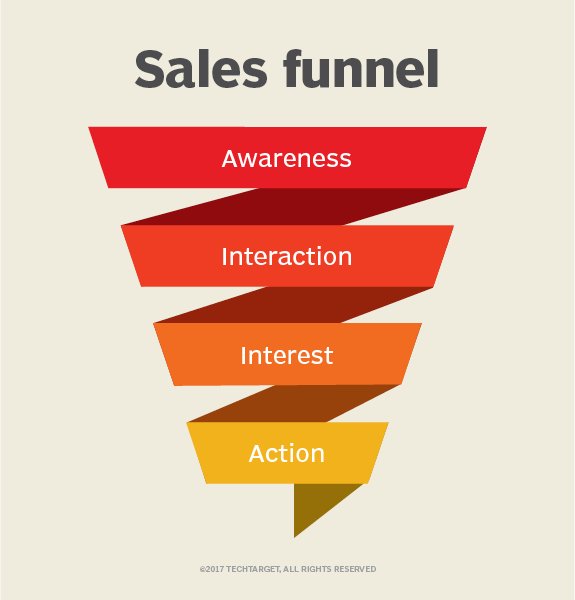
-Source: techtarget.com
Here are the steps you need take to move your prospects down the sales funnel towards your premium consulting offer:
1. High-Quality Blog Content:
Attracting users with valuable content is crucial.
Your content should not only showcase your expertise but also provide real value to your audience.
It establishes credibility and draws potential leads who are interested in your services.
2. Email List Opt-In:
Offering a freebie or lead magnet in exchange for an email opt-in is an excellent tactic to generate leads.
The freebie should be something of value to your audience, it could be a free guide, webinar, challenge, or email series, addressing a pain point or providing a solution.
This step will help you build your email list, which is an important asset when thinking about how to make money blogging.
3. Lower-Priced Offer (Optional):
Introducing a lower-priced offer in the $50-$250 range can help you build trust.
It serves as an entry point for prospects to experience your service at a lower commitment level.
4. Automated Email Welcome Series:
Setting up an automated email sequence is an effective way to engage with your audience consistently.
Craft the welcome email series strategically to guide leads through the funnel, providing value, tackling pain points, and gradually leading them towards the desired action, such as setting up a meeting.
5. Close the High-End Offer:
By the time the leads reach the bottom of the funnel, they should’ve been educated about your offerings and ready to set a meeting.
Allowing for a more personalized interaction where you can address specific needs and concerns, and close the high-end consulting sale.
Ultimately, there is nothing fancy about learning how to make money blogging.
In the early days, it comes down to publishing 5-10 (pillar posts) long-form, high-quality articles, a lead magnet freebie, an email list building platform and a consulting page.
Your leads optimized sales funnel will do the rest.
Premium Consulting Offer
For your premium consulting offer to work, position your blog in a lucrative niche, where the audience is willing to pay top dollar for a solution to their problem.
To generate $2,500 per sale, focus on business clients instead of individuals.
Businesses have bigger budgets and consulting costs are written off as business expenses.
Take the personal training niche, as an example.
Let’s say you have knowledge about scaling businesses by taking them online.
Rather than targeting aspiring fitness instructors with no earnings who want to build a business, hone in on the already successful personal trainers making $10,000/month or more.
Go after small business owners or solepreneurs who want to take their businesses online, automate and scale them, but don’t have the knowledge to do it.
Valuable solutions to address their pain point could include, helping them:
- Build a training app (outsource the development work).
- Establish own team of personal trainers.
- Create online training and nutrition courses.
- Start a membership site.
- With content marketing solutions.
- Social media strategies.
- Sales funnel optimization.
In this case, paying $2,500 for consulting is seen as affordable and worthwhile business expense, considering the potential ROI (return on investment).
To achieve sales, focus on driving traffic to your consulting page by using SEO strategies.
Conduct keyword research to identify the terms your target clients are searching for and include them in your content.
Ensure that your consulting page is easily accessible from the top-level navigation menu of your blog.
Include your professional image and contact information.
Strategically link back to your consulting page from key areas of your blog, such as the home page, about page, and blog posts.
This helps direct visitors to your consulting services and encourages them to learn more.
When you’re contributing guest posts to other websites include a link to your consulting page in your author bio to drive additional traffic.
Build an Email List
Building an email list is a fundamental element of the sales funnel.
It enables you to capture prospective leads, which can be converted into paying customers through strategic email marketing campaigns.
To build an email marketing list you need an onsite email opt-in tool and email marketing software.
On-site Email Opt-in Tool: OptinMonster
- It’s a WordPress plug-in that integrates seamlessly with ConvertKit.
- Offers you various opt-in types, including exit-intent pop-ups, sidebar opt-ins, and opt-in forms within blog posts, ensuring that opt-in opportunities are presented to visitors at optimal moments during their browsing experience.
Use a combination of sidebar opt-ins, page-specific opt-ins, end-of-blog post opt-ins and exit-intent pop-ups to capture the maximum number of email subscribers at various touch points.
Email Marketing Software: ConvertKit
It’s the preferred email marketing tool by bloggers for several reasons:
- Allows you to create advanced email sequences and personalized communication tailored to the specific interests of your subscribers.
- Enables you to automate drip campaigns and linking sequences based on actions taken by subscribers within your emails.
- Provides professional-looking text emails without intrusive branding like other platforms.
Professional-looking text emails increase conversion by more than 156%.
So, keep your emails simple.
Don’t overcomplicate them with fancy designs, images, charts, graphs or logos.
Here are some tips to help you craft text emails that engage recipients and drive action:
- Personalize the email subject line and greeting because 72% of all recipients engage only with personalized emails.
- Use short paragraphs and bullet points to improve readability.
- Place your call-to-action (CTA) on a separate line, so it stands out.
- Test on different devices to ensure readability and find any layout issues.
In summary, when using email opt-in together with email marketing software, you maximize the number of potential visitors entering your email funnel and increase their conversion into paying customers.
How Much Money Can I Make Blogging?
Some bloggers make 6 and even 7 figures per year, while others make little to no money at all.
The amount of money you can make blogging depends on factors like niche, audience size, and use of monetization strategies.
New bloggers often aim for $10,000 in their first 12 months of blogging.
However, with my strategy on how to make money blogging you can easily hit $10,000 a month in 12 weeks.
By following my plan, you’ll focus on targeted outreach, personalized communication, and tailored proposals to secure 1-2 high-paying consulting clients in the first 4 weeks of your blog launch.
From week 4 to 12 you will continue consulting, but your main focus will shift to scaling your blog content and acquiring backlinks, laying the foundation for your transition from consulting to passive income like affiliate marketing and ads.
Let’s break down this strategy into actionable steps:
After choosing a niche, take your blog online.
Setting Up and Preparation
Set up the necessary platforms and tools or the support system of your blog and high-ticket sales strategy.
Blog Launch
- Set up your WordPress blog using Bluehost.
- Create essential pages like: Home Page, About Page, Consulting Page, Email Opt-In Page and Contact Page.
Email Marketing Setup
- Configure OptinMonster to captures leads through opt-ins strategically placed in blog posts, sidebar, and triggered upon exit intent.
- Offer a lead magnet such as a free consultation, or webinar to provide additional value and incentivise sign-ups.
- Add lead optimized sales funnel with automated email series, using ConvertKit.
Position Yourself as an Expert
- Publish 5-10 long-form high-quality blog posts that align with your niche and high-ticket offering, showcasing your expertise.
- Craft automated email series that educate leads, address pain points, tackle objections, and highlight the benefits of working with you.
- Use AI writing assistants and freelancers to speed up the writing process.
Once you’ve covered these steps you’re ready to start monetizing your blog.
Week 1: Networking and Research
Aim to initiate contact with bloggers and potential clients to demonstrate your expertise and value proposition.
Research
- Make a list of 100 high domain authority blogs in your niche that accept guest posts.
- Add the contact details and emails addresses of the editors to the list.
- Connect with them on LinkedIn and begin your outreach via email.
- Use well-crafted pitches offering valuable content ideas.
- Aim to secure 2 guest posts contributions.
Professional Contacts
- Leverage your former colleagues, classmates, mentors, industry peers, or friends who operate businesses in your niche.
- Reach out and mention your blogging venture and how you can provide value to them through consulting.
Create a Customer Avatar
- Define your ideal client profile based on industry, demographics, pain points and budget.
- Research their pain points, challenges, and needs to tailor your offerings effectively.
Community Networking
- Join blogging communities on LinkedIn, Facebook and blogging platforms.
Week 2: Outreach and Relationship Building
Aim to increase your blog’s visibility and authority within your niche and start relationships with influencers and potential clients.
Outreach
- Submit your guest posts to the agreed-upon platforms.
- Follow their guidelines and ensure your content meets their standards.
- Engage with the audience on those platforms to maximize the impact of your guest posts.
- Continue the outreach to secure 3 more guest blog posts.
Professional Contacts
- Generate leads through your professional network.
High-Ticket Consulting Offer
- Make a list of 100 potential business clients within your niche.
- Craft personalized email pitches tailored to each potential client.
- Highlight how your services can address their specific pain points and deliver value.
Community Networking
- Start building connections with influencers and professionals in your industry through LinkedIn, Facebook, and blogging platforms.
Week 3: Consultations and Proposals
Aim to conduct consultations to understand client needs and propose tailored solutions.
Outreach
- Get 3 more guest posts approved.
- Use the relationships you’ve established with bloggers to engage in link building.
High-Ticket Consulting Offer
- Follow up with leads generated through your blog, guest posts, and professional networks.
- Schedule consultation calls to understand their challenges, goals, and budget.
Community Networking
- Continue to develop relationships with your audience through regular content updates and engagement.
Week 4: Close Sales and On-Boarding
Aim to finalize agreements with potential clients and secure commitments.
Outreach
- Get approved for 3 more guest posts to drive further traffic to your blog.
- Continue building relationships with bloggers and influencers in your niche.
- Attend relevant online events or webinars to expand your network.
Negotiations
- Negotiate terms and pricing with clients based on budget and needs.
- Overcome objections and address any concerns to facilitate agreements.
Performance Evaluation
- Analyze the performance of your blog posts, guest posts, and email campaigns.
- Identify areas of improvement and adjust your strategy.
This guide only covers the first 4 weeks of how to make money blogging.
Sign up for my free 10,000+ words email course that includes a 7-days blog launch checklist and the full 3 months plan to reaching $10,000.
Consulting is going to be a stepping stone if your goal is to generate passive income with your blog.
Let me explain.
Use part of your consulting income to fund the use of AI writing assistants like Jasper or freelance writers, so you can accelerate your content creation.
This will allow you to focus on outreach, building relationships and acquiring backlinks that will increase your domain authority and drive organic traffic to your blog.
Once you have 20,000 monthly visitors you can swiftly shift from consulting to more passive income streams like ads and affiliate marketing.
Passive Income from Affiliate Marketing
Affiliate marketing is best way to generate passive income with a blog that have consistent traffic.
You can make money 24/7 without much input and you no longer need to trade time for money.
With affiliate marketing you don’t have to develop your own product or service, manage inventory, or handle customer service.
You earn commissions by promoting products or services created by other companies.
Here is how to making money blogging with affiliate programs:
Sign up: Join an affiliate programs directly or via affiliate networks.
Receive tracking link: Upon approval, you receive a unique affiliate tracking link and access to performance data and reports.
You can track: clicks, sales, and any future payments due to be paid to you.
Link integration: Insert the link into your blog content.
Tracking activity: When a user clicks on your affiliate link, they’re redirected to the company’s website.
At the same time, a tiny file (cookie), tracking activity for 30 to 90 days is stored in their browser.
Even if a transaction isn’t made on the spot, any purchases during the tracking period are still credited to you.
Transaction: Customer makes a purchase from the website.
Sale: The sale is recorded through your tracking link.
Payment: You get paid commission on the sale through PayPal or bank deposit.
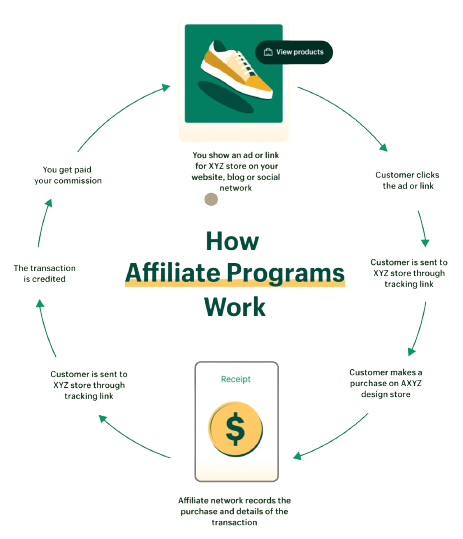
– Source: shopify
Affiliate programs are free to join and since there’s no upfront cost you can start generating revenue right away after signing up.
You can earn up to 75% commission per sale, depending on the product or service you recommend and the terms of the affiliate program.
Some programs offer a flat rate per sale.
Others provide recurring commission for ongoing subscriptions.
There are also affiliate programs with one-time payments per sale.
To generate passive income with an affiliate blog, you need to be in a lucrative niche with strong affiliate revenue potential.
Some of the most profitable blog niches are: personal finance, marketing, travel, technology, crypto, making money online, fitness and wellbeing.
Study the most successful blogs in your niche.
What topics do they cover?
How do they present the content?
Why are they recommending specific products and services?
Are these companies paying the highest commission?
Do they use product reviews, banners, or email newsletters?
Understanding their tactics will help you develop your own strategies for effectively promoting affiliate products on your blog.
Good source of inspiration and ideas are blogs like:
- Crypto/Stocks – CryptoVantage, HedgeWithCrypto, Benzinga
- Technology – Gizmodo, TheVerge, CNET, TechRadar
- Finance – MillennialMoney, GoodFinancialCents, TheCollegeInvestor
- Fitness & Wellbeing – Health.com, Prevention, MensHealth, Self.com
- Software – G2.com, PCmag, SoftwareReviews.com
All these blogs publish long-form, high-quality reviews and how-to articles.
The blog posts that generate the most revenue are list or review posts, including the word “best” in their title.
These are transactional posts with high search volume and conversion.
People searching for “best + product or service” have high purchase intent.
They’ve already identified their need or desire for a particular product or service and are seeking information to support the purchase decision.
If you Google “best electric bikes”, the results on the first page are only affiliate blogs.
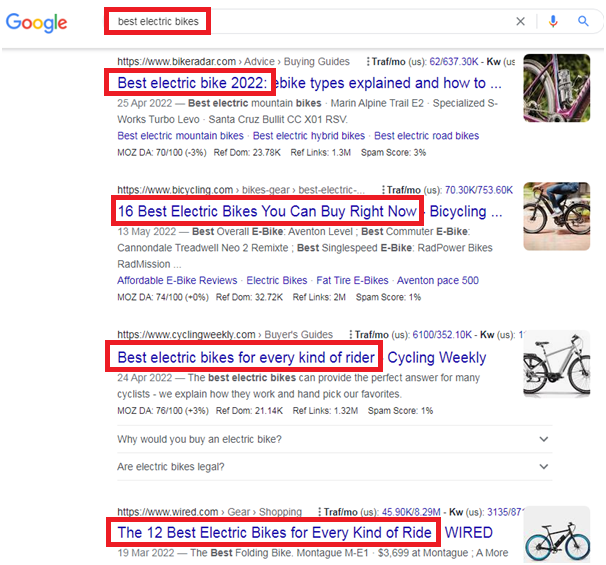
Visiting one of the websites will take you to a list-type blog post, reviewing the best e-bikes, with an affiliate link to buy the product.
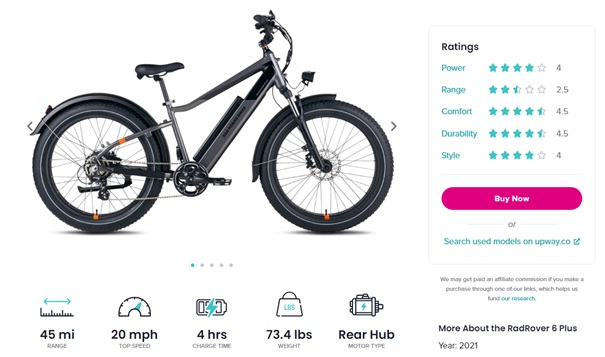
If you click the Buy Now button, you’re redirected to the official website selling the e-bikes, where you can complete the purchase.
The affiliate blog receives commission for every sale.
The “best electric bikes” has over 93,000 monthly searches, generating a hefty passive affiliate income just from one blog post.
You can repeat the search for “best crypto cold wallets” or “best cameras for underwater photography” and you’ll get the same results packed with affiliate blog posts.
With every search you’ll notice that affiliate blogs are everywhere on the internet.
You’ll also notice that the retail websites don’t rank on the first page of the search results.
Why is that?
The blogs publish long-form content, which performs better in search engine rankings because it provides more value and in-depth information to the readers.
Therefore, to make money blogging through affiliate marketing select a profitable blog niche.
Join high-paying affiliate programs.
Aggressively publish quality transactional blog posts.
And avoid writing aimless informational articles that lack monetization options.
How to Make Money Blogging: FAQ
Here are some of the most frequently asked questions by new bloggers about how to make money blogging.
Q: Is blogging a good way to make money?
A: Yes, blogging is definitely a good way to make money.
Many bloggers have turned their blogs into successful businesses and lucrative income streams.
Some of the reasons why blogging is still the best way to make money online include:
1. Starting a blog doesn’t require significant upfront investment.
You can set up your blog on WordPress for free, and take it online with Bluehost for only $2.45/month.
2. Flexibility.
Blogging allows you to work from anywhere in the world at any time.
3. You’re not limited to one income source.
There are various ways to monetize a blog, including: advertising, affiliate marketing, digital product or service sales, sponsored content, consulting, etc.
4. A blog is easy to scale.
As your audience grows, you can introduce new income streams to generate more revenue.
5. Source of passive income.
After you’ve built a library of evergreen content, your blog will continue to attract visitors and generate income on autopilot.
Q: Do beginner bloggers make money?
A: Beginner bloggers can make money, although it may take a few years if you follow outdated advice or methods that don’t align with current trends.
To monetizing your blog faster, consider the following.
Instead of writing a ton of content and stuffing it with affiliate links, and ads which require a large audience and time to make you money, try a different approach.
While your blog is new and traffic is low, offer high-ticket consulting service that will make you $2,500+ per client.
High-ticket consulting will generate you significant income with fewer transactions compared to earning affiliate commissions that need large volume of traffic for substantial earnings.
Then use the consulting income to hire writing help in the form of AI-writing assistants or freelancers to scale your blog content rapidly, while you engage in backlink building.
And finally, pivot towards affiliate marketing and ads, a more passive way how to making money blogging.
Q: What type of blog is best to earn money?
A: The best blogs to earn money share common characteristics that contribute to their success.
Two key factors are: the availability of effective blog monetization options and targeting an audience that is willing to pay for solutions to their pain point.
The types of blogs that perform well monetarily include:
- Personal finance
- Health & wellness
- Food and recipe
- Parenting and family
- Travel
- Tech and gadget
- Interior design & home improvements
- Fashion
On the other hand, if your goal is to earn money blogging, you want to avoid personal diaries, journals, general news aggregation, and highly personal type of blogs that lack monetization opportunities.
Q: How do bloggers get paid?
A: Bloggers get paid through various income streams depending on their niche, audience and business model.
The most common blog monetization methods are:
Advertising Revenue:
- Ads Display: displaying ads on their websites using Google AdSense or advertising networks and earn revenue based on ad impressions (CPM) or clicks (CPC).
- Direct Ad Sales: selling ad space directly to businesses or advertisers.
Affiliate Marketing:
- Bloggers can join affiliate marketing programs to promote other companies products or services within their content and earn a commission when readers make purchases through their affiliate links.
Sponsored Content:
- Brands pay bloggers to create content promoting their products or services. This can include sponsored blog posts, product reviews, or mentions on social media platforms.
Selling Digital Products:
- Bloggers can create and sell digital products such as e-books, online courses, templates, or software, leveraging their expertise and audience to generate sales.
Membership or Subscription Models:
- Some bloggers offer premium content or membership access to exclusive content for a recurring fee. Platforms like Patreon enable bloggers to monetize their content through subscriptions.
Freelance Writing and Guest Blogging:
- Earning income by providing freelance writing services for other publications or accepting guest blogging opportunities on other websites.
Consulting or Coaching Services:
- Bloggers with expertise in specific niches can offer consulting or coaching services to their audience for a fee.
Selling Physical Products:
- Selling products related to their niche including merchandise, handmade crafts, or branded items.
Events and Workshops:
- Successful bloggers can host events, workshops, or webinars for their audience, charging admission or registration fees.
Donations and Crowdfunding:
- Bloggers can accept donations from their audience through platforms like PayPal or Patreon.
Partnerships and Collaborations:
- Collaborating with other bloggers, influencers, or brands on joint projects or campaigns, which can lead to additional revenue opportunities.
Q: Can you make $1,000 a month with a blog?
A: Earning $1,000 a month or more from a blog is certainly achievable.
But if you use the correct monetization strategies you can reach this level of income and beyond faster.
Here are some tips and considerations to help you towards earning $1,000 per month from your blog:
You can use the traditional blogging approach and focus on writing valuable content, building an engaged audience, and experimenting with different monetization strategies.
While this approach will eventually get you to your $1,000 a month goal, it’ll take you a lot of time and consistency.
Or you can take a more unorthodox approach.
Leverage your expertise from day one, using your blog as a platform to sell high-end consulting services priced between $1,500 and $2,500.
When your blog gains traction you can shift to passive income generation from affiliate marketing, advertising, and sales of digital products.
Q: Who is the highest paid blogger
A: The wealthiest bloggers change over time due to varying income sources and trends in digital media.
However, the top 5 highest-paid bloggers are:
- Tim Sykes ($1 million per month)
- Chiara Ferragni ($250,000 per month)
- Melyssa Griffin ($238,000 per month)
- Sarah Titus ($200,000 per month)
- Pat Flynn ($200,000 per month)
How to Make Money Blogging: Final Thoughts
In conclusion, if your goal is to master how to make money blogging, it’s essential to understand the key revenue drivers and structure your blog content and monetization strategy around them.
But first and foremost, a successful money-making blog start with the choice of hosting service.
Start with Bluehost for £2.45/month and get 80% off your hosting plan.
Once your blog is online, select your blog niche based on business metrics, not passion.
You goal is to build a business not become a copywriter.
Analyze market demand, trends, and monetization potential before deciding on your blog topic.
Use Semrush to identify profitable niches and keywords with high-search volume and low-competition.
Consider areas with clear audience demand, where you can provide valuable services and content.
The best way to monetize a new blog is through consulting.
Consulting services leverage your expertise directly and generate income quickly.
While consulting provides immediate income, the ultimate goal when thinking about how to make money blogging should be creating passive income.
Affiliate marketing is the best ways to achieve this.
As you grow your blog and audience, start adding affiliate links to your content.
Sign up for affiliate programs related to your niche and promote products or services that provide value to your readers.
Publish reviews, create how-to guides, and share personal experiences to build trust.
Over time, as your blog traffic and content increases, so will your affiliate earnings.
There you have it, this is how to make money blogging.
How to Make Money Blogging: Related Content
If you’re interested in learning more about blogging, here are some recommended articles on MonetizingOnline.com that you’ll find helpful.
You can check out:
Disclaimer: This how to make money blogging article contains affiliate links. If you purchase a paid plan through my links, I may receive small affiliate compensation at no cost to you. You can read my affiliate disclosure by going to my privacy policy. This blog is for informational purposes only and does not constitute financial advice.




This is exactly what I needed to read today. Your words have given me a new perspective. Thank you
Thank you for the kind words, Mayson!